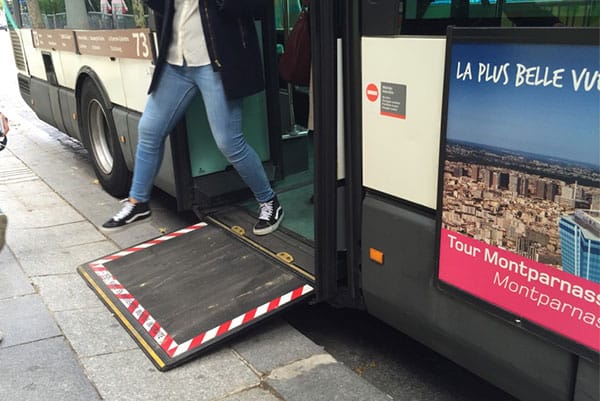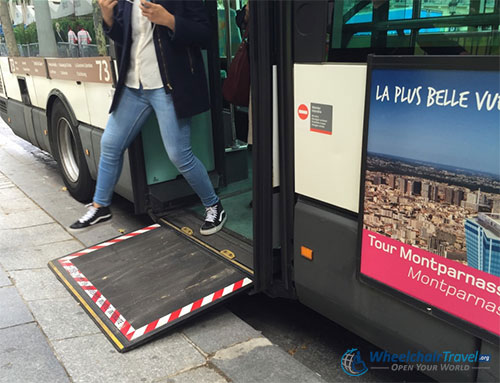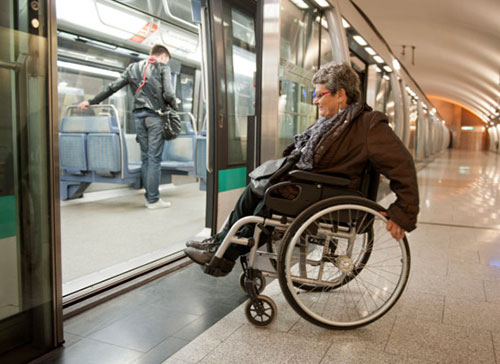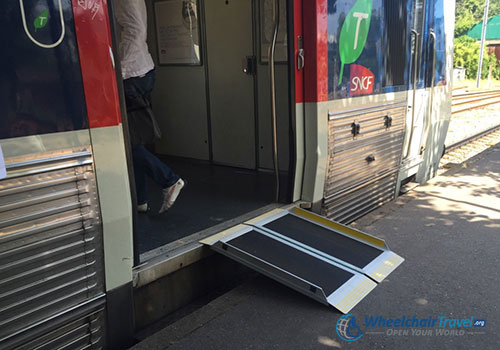
The public transportation system in Paris is steadily increasing in accessibility to wheelchair users. Use of this transportation network will require some advance planning. Nearly all of the city’s buses are wheelchair accessible. The city’s subway system, with the exception of line 14, is largely inaccessible and should be avoided. Many of the on-street tram lines offer easy roll-on/roll-off access.
City Bus

The city buses in Paris are operated by Regie Autonome des Transports Parisiens, RATP. Almost all of the city’s standard bus routes are operated by wheelchair accessible buses. These buses have lowered floors and an electronic ramp at the center door which permits easy roll-on/roll-off access. One wheelchair space is available on each bus, though securement straps are not often available.
Fares and tickets for the city’s RATP bus service are separate from those of the Metro Subway. For the city bus, one way fares can be purchased onboard for €2,00. Fare cards purchased in advance from a ticket office or sales outlet are €1,80 per ride.
In practice, disabled passengers in wheelchairs ride free on the city’s bus network. Travelers without an apparent physical disability are required to apply for a disability identification card. A 50% fare discount is offered to passengers with disabilities. Information on reduced fares is available at www.ratp.fr.
Like other cities, Paris offers a transit card, the Navigo Pass, but the hassle of purchasing one and the set period of validity makes the pass a bad choice for tourists. More information is available in this About.com article.
The Paris Visite Pass is the best option for tourists, as it allows unlimited travel through either the central (1-3) or all zones (1-5) of the city’s public transportation system for 1, 2, 3 or 5 consecutive days. These passes start at $15.00 USD for one day and can be purchased online through Rail Europe quickly and easily. The Visite Pass allows for use of the city bus, metro subway, tram lines and RER trains.
Metro Subway

The Paris Metropolitan Subway is spread across 16 lines and serves 303 stations throughout the city and the surrounding areas. The majority of stations are not equipped to accommodate wheelchairs. Lengthy stairways, large gaps between train and platform, and a lack of elevators make wheelchair access unavailable. The newest line, 14, is fully accessible, and there is a hope that future construction and renovation will lead to greater accessibility in the subway system. Line 14 features elevators at all stations and a minimal gap between the subway train and station platform. These accommodations allow wheelchair users to make use of the line without any special assistance from station personnel. For more information on the metro’s accessibility, or for maps of Line 14, click here.
I personally recommend that persons with mobility challenges and power wheelchairs use the accessible city bus network and avoid the subway, unless Line 14 service works well for your needs on a particular journey.
Tramways
Nine Tramway lines operate within the City of Paris and the surrounding metropolitan area. The network serves 186 total stations. Each tram has a low floor that is even with the station platform. All station platforms can be accessed via either a short ramp with a slight incline or an elevator. Wheelchair users can roll on and off the trams unaided. For more information on the accessible accommodations installed on the Tramways, click here. For route maps and service times, click here.
Montmartre Funicular
The Montmartre Butte is the highest elevation in the City of Paris. A funicular travels between its foot and summit, allowing pedestrians and wheelchair users to bypass the more than 300 steps that must otherwise be used to ascend the hill. At the summit sits the Sacre-Couer, or Basilica of the Sacred Heart. It is one of the most beautiful churches in Paris and the whole of Europe. The funicular climbs 36m (118 ft.) in about a minute.
The video above shows this ascent. The first funicular opened on the site in 1900, but the current system was installed in 1991. It transports more than 2 million passengers per year. The funicular cabin and stations are entirely wheelchair accessible. Tickets are €1,80 in each direction and can be purchased at the ticket booth next to the entrance gates.
RER Regional Trains

The RER is a network of regional rail service connecting Paris to the outlying suburbs, airports and attractions like the Palace of Versailles. The network consists of 10 lines: A, B, C, D, E, H, J, L, N and U. Both airports are connected to the RER’s B line via either the CDG VAL or Orlyval shuttle train.
RER trains are wheelchair accessible via the ramp pictured here. It is placed manually by station staff. Reservations can be made in advance, or requested at the information or ticket counter at most stations. However, not all stations are constantly staffed, meaning that they are not all accessible. For a list of accessible stations by line, click here.
Fares for travel on the RER trains range from €1,80 to €11,00. These prices are dependent upon how far you wish to travel and how many zones your journey will cross. The standard €1,80 fare is for travel only within the City of Paris.
International Rail
If you wish to travel internationally by train from Paris, it is very possible that you will begin your journey at the Gare du Nord train station. Trains with service to Northern France, Belgium, Germany, the Netherlands and the United Kingdom operate from Gare du Nord. These rail providers include Eurostar, Thalys and TGV, among others. The station, which serves more passengers than any other in Europe, is fully wheelchair accessible.



